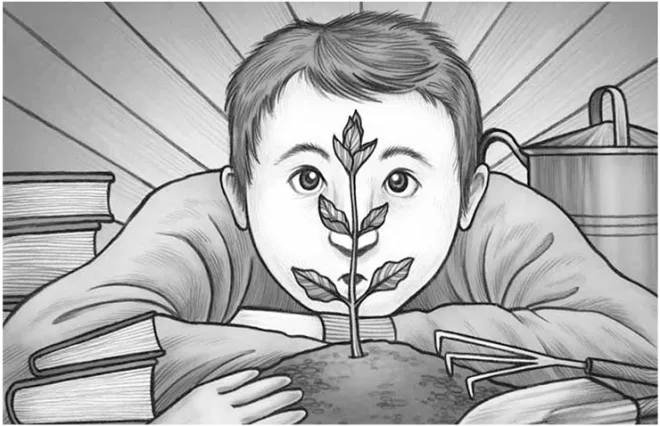I‘ve worked in the nursery business here in Napa, California for 15 years. During that time I’ve learned that my job is to help grow gardeners just as much as plants. Especially in spring.
Spring in our nursery is a happy time. The bedding plants are a riot of color, and the eager young vegetables grow right before your eyes. Flushed with hope and fresh resolve, shoppers load their carts with more than they can use, for who can resist the tangerine zinnias, the deep blue delphiniums, the baby stalks of corn, and all those heirloom tomatoes, each one promising some-thing special. The is The Year, customers vow, the year they will have their dream garden.
Because people are impatient and we must keep pace with the box store down the street—that hulking nemesis—we bring in spring stock sooner than is best. Despite our cautions, many folks buy cartloads of these greenhoused plants and plunge them into cold soil on a promising sunny day. That night, or maybe the next, a hard frost steals into their gardens, blackening the basil and wilting the water-melon. The disgruntled patrons then return for replacements, digging into their pockets a second time, albeit not quite so cheerfully.
Eventually the soil warms, winter unhooks its talons, and we assure everyone that they can garden with abandon. Plants stream into the nursery—and are cleared out the same day. We take special orders for Tati’s Wedding tomatoes, Jersey Pickling cucumbers, Golden California Wonder peppers. Oh, the bounty! The excitement!

Busy shoving wondrous things into the earth, many of these eager gardeners fail to notice tiny green aphids in the broccoli, tunnels forming in the Swiss chard leaves, or a shroud of white fungus creeping over the zucchini. Not until their gardens are riddled with trouble do people perceive a problem. How they react depends on who they are. Some, blaming nature, turn on it. They buy the most deadly products they can get their hands on and turn their gardens into battle zones. Others, blaming us, storm back into the nursery, brandishing their sickly specimens and demanding a refund. They will cite the return policies of the box stores and threaten to take their business to them.
And then there are those who blame themselves. They come into the nursery shamefaced, holding plastic bags of evidence and asking us what went wrong. Why are they such bad gardeners? Disgusted, they give up. There are too many variables, they complain, too much they can’t control.
We have removed the most devastating munitions from our shelves, especially anything containing bee-killing neonicotinoids; soil drench versions are the worst as they contaminate soil and groundwater for years to come. We have also eliminated herbicides containing glyphosate (Roundup, KleenUp, Remuda). Not only is glyphosate a probable human carcinogen, it has a lethal impact on aquatic and terrestrial amphibians. We encourage gardeners to make their own herbicides and pesticides using household products like Epsom salts, cooking oil, and dish soap—recipes for these remedies abound on the Internet.
But even organic solutions should be applied judiciously. Medicating plants week after week can erode their health. Plants, like people, defend themselves when threatened. To save its strength, a Ficus benjamina will drop its leaves after the shock of relocation, then tentatively grow them back. In response to beetle attacks, a conifer will release wads of resin, sealing its wounds and embalming the marauders.
The most important thing you can give your plants is a good start: amended soil, room, and the proper light and water. A rose will not appreciate a shady location or the overspray from lawn sprinklers; cannas relish both. You can save yourself time and money by learning what plants require before you grow them.
That said, your yard will never be perfect because nature isn’t perfect. Accepting this will make you a better gardener, one who slows down for a closer look in an effort to understand. There are reasons for almost everything, like why your doublefile viburnum hasn’t bloomed. Plants moved from their pots into the open ground will often take years to flower: They may be spending their energy below, establishing roots. This is why a lemon tree in a container will produce fruit sooner than a tree in the ground. The roots meet the boundary of the pot and, running out of room, signal reproduction. And those skinny leaves on that nandina? No, it’s not sick, it just needs more water—check the irrigation.
Sometimes a plant is simply destined to fail. Maybe it was weak from the start; maybe it was neglected too long; maybe it simply grew old and frail, no longer able to fend off attackers. Removing it does not mean you failed. It means you cared.
If you want to be a good gardener, start with humility. You are, after all, asking this Earth for miracles: giant sunflowers, golden watermelon, crimson peonies. You are bound to lose a few things to bugs or blight; think of this as giving back and plant anyway. Make peace with your garden and arm yourself with knowledge.
Above all, treat your plants—and yourself—with gentleness. ❖



